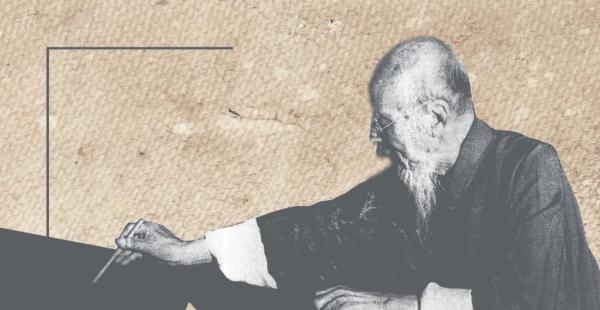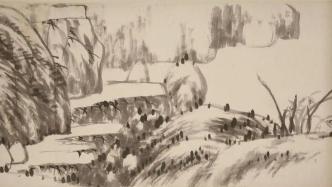
Among the "Top Ten Boutiques" of national museums in 2023 announced on the "5.18 International Museum Day", Tianjin Museum's "Flowers on the River: The Tao of Chinese Flower-and-Bird Painting" was selected as a boutique promotion project for outbound exhibitions.
On May 18, "Flowers on the River - Chinese Flower-and-Bird Painting, 1368-1911 (Return to China Exhibition)" opened at the Tianjin Museum. The exhibition was based on the exhibition in the United States and featured 55 pieces/sets of flower-and-bird paintings from the Ming and Qing Dynasties. , among which the 13-meter-long picture part of "Flowers on the River", a masterpiece by Bada Shanren, is fully unfolded.

exhibition site
In 2023, "Flowers on the River: Chinese Flower-and-Bird Painting 1368-1911—Selected Collections" will be exhibited at the National Art Museum of China and the Santa Barbara Art Museum in New York, USA. It is the international exchange project with the largest number of cultural relics sent abroad, the longest preparation time, and the greatest influence in the history of Tianjin Museum. Since the opening of the exhibition, visitors have come in an endless stream and the response has been enthusiastic. While admiring the exquisite and precious authentic Chinese flower-and-bird paintings, foreign visitors have a deep understanding of the Oriental artistic technique of "placing feelings on things" and the Chinese wisdom contained in it.

"Flowers on the River: Chinese Flower-and-Bird Painting 1368-1911—Selected Collections" Exhibition in the United States
In order to give back to the domestic audience and friends, and on the premise of standardizing the protection of cultural relics, "Flowers on the River - Chinese Flower and Bird Painting, 1368-1911 (Return to the Country Exhibition)" selects 55 pieces/set from Tianbo's exhibition in the United States. The Qing Dynasty flower and bird painting collection includes representative flower and bird paintings by important painting schools and painters such as the Ming Dynasty courtyard painting, Wumen School, Jinling School, Four Monks, Yun School, Yangzhou School, and Shanghai School, and is presented to Hometown audience. In the context of humanities and history, we explore the relationship between the natural world and Chinese people's daily lives and social customs, and describe the creative tradition of "meaning and happiness" in Chinese paintings and the philosophical thought and humanistic spirit of "the unity of nature and man" contained in it.

exhibition site
Among them, the 13-meter-long painting "Flowers on the River" by Bada Shanren, which is the soul of the exhibition, is fully unfolded. The artist's self-titled "Song of Flowers on the River" is displayed behind the cultural relics in the form of spray painting.
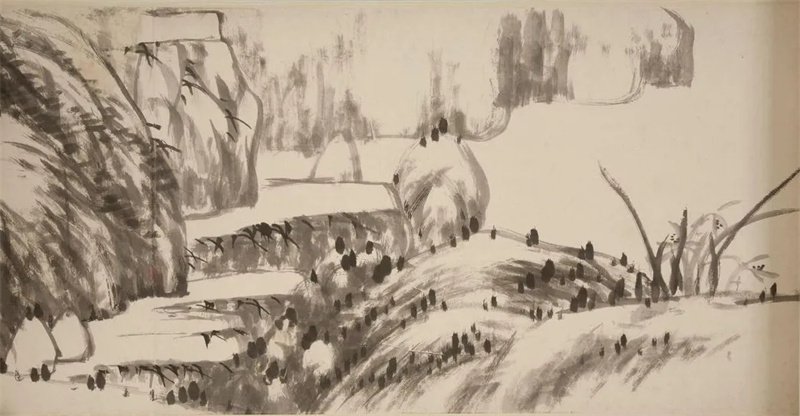
Qing Dynasty Badashanren Flowers on the River (detail)
Inscription: Mr. Hui Geng painted this volume. From May to June, July and August in Dingchou, lotus leaves and lotus flowers are completed. The play is a song of flowers on the river, with only more than 200 words in full form. Bada Shanren.
In the picture, three or four lotus stems are painted at the beginning of the scroll, scattered and scattered. Then it becomes dense and becomes a piece, and the lotus stems are horizontal and oblique. The lotus flowers are either in bud or in full bloom, with different postures and full of vitality. The second half is painted with rocks, orchids and bamboos, and rock slopes with flowing springs. The whole volume is full of ups and downs, like a gorgeous piece of music. The painter uses surging passion and skillful techniques to create freehand lotus flowers. The brush and ink overlap, the shades and shades break up each other, the moistness penetrates, and the pure air fills the paper. The lotus flower is written with a clear and round pen, and the lotus stem is written with the center. The pen power is inherent, like iron wrapped in cotton. The slope stones are scratched with dry ink using a bare pen, making them green, moist and thick.
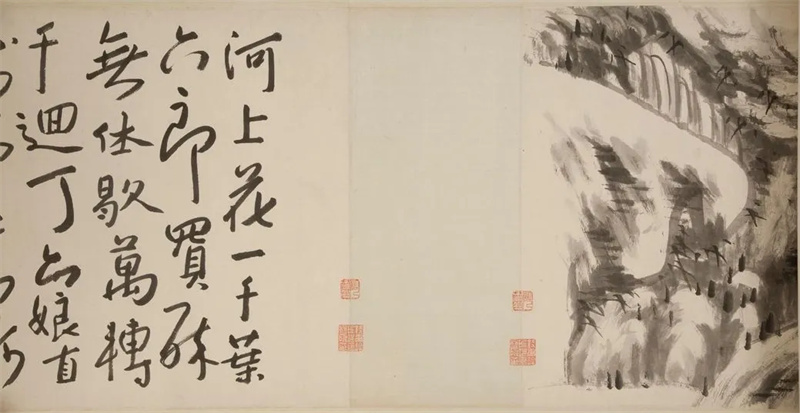
Qing Dynasty Badashanren Flowers on the River (detail)
The theme of lotus accounts for a large proportion in Bada Shanren's handed down works, which shows that he has a special liking for lotus. This painting of lotus is summarized and vivid, and the brushwork and ink are both free and implicit. It is not the same as the freehand painting techniques of Chen Chun and Xu Wei. It can be said that the freehand brushwork technique of Chinese ink and wash has been brought into full play, and it can be called a masterpiece of Bada Shanren. At the end of the painting, the artist wrote the song of flowers on the river in cursive script. Ding Chou in the inscription was in the 36th year of Kangxi's reign (1697), and the painter was 72 years old at that time.

Ming Dynasty, Lu Ji, Four Happiness scrolls
Other key exhibitions include Lu Ji's "Four Happiness Scroll", Xu Wei's "Fish and Crab Scroll", Zheng Xie's "Scroll of Wonderful Fragrance on the Mountain Top", etc.
Lu Ji (about 1439-1505), whose courtesy name was Tingzhen and his nickname was Leyu. A native of Yin (now Ningbo, Zhejiang). During the Hongzhi period, he was recruited into the Painting Academy to serve in the Hall of Renzhi, and was promoted to the command of the Jinyi Guards. He is good at painting flowers and birds. He recently studied the "Yuan Style" style of Bian Jingzhao and Yuan Zong in the Southern Song Dynasty, and made slight changes. Most of them are based on songbirds such as phoenixes, cranes, peacocks, and mandarin ducks, mixed with flowers, trees, grass and stones, all of which are full of vitality. He also creates freehand brushwork in ink and wash, with vigorous and unrestrained brushstrokes. As famous as Lin Liang.
The silk scroll depicts birds among mountains, rocks and waterfalls in a snowy landscape. The author's meticulous sketching and freehand ink painting are integrated into one. The birds he painted are concise and expressive, lifelike and quite powerful. The slope stones are cracked with an axe, and the pen and ink are refreshing. The painting was influenced by Lin Liang's freehand flower and bird style.
Chinese folklore says that magpies can bring good news, so they are called magpies, which means auspiciousness, happy events and good luck. "Four Happinesses" is a common theme in traditional Chinese paintings, implying the auspicious meanings of fortune, wealth, longevity and joy.

Ming Dynasty Xu Wei's Fish and Crab Illustration: "Where does the claw go? It will be lost to the god of the sea." Long article.
The paper is full of cold birds blowing in the hyena wind, and the plain scales fly out of the ink pond. I hate that there are so many naked eyes in the floating world, who understands that all the makeup is from the dragon. Weibao.
Xu Wei (1521-1593) was born in Shanyin (now Shaoxing, Zhejiang Province). His courtesy name was Wenqing, and his courtesy name was Wenchang. His nicknames were Tianchi and Qingteng Laoren. Good at poetry, calligraphy, flowers, landscapes and figures. He is good at painting flowers and birds with ink and freehand brushwork. His brushwork is wild and varied, and his brushwork has a huge influence on later generations.
This volume is divided into two sections, with one poem and one painting, which is Xu Wei's most common method of organizing pictures. The front section is painted with reed crabs, reeds and willow leaves, with meticulous and loose brushstrokes. The control of the shades of ink depicts the crab. The dark carapace is painted with thick ink to show its hard texture, and the transparent texture of the claws is painted with light ink. The effect is natural and vivid, and the tips of the claws are painted with fine lines. The strong ink strokes are the finishing touch. The two paintings are independent but connected by looming water waves, which shows the author's ingenuity. As the water waves become thicker, a carp is flying on the top of the waves. The author only draws the rising head and tail of the fish, and freezes the moment when the fish is about to jump out of the water. A few clusters of ink dots show the splashing water. The effect, the picture effect is soaring and flowing, as if there is a "cold smell" coming towards the face.
The painter does not stick to the appearance, but directly depicts the object with the method of wild cursive and splashing ink. The brush is wild and wild, the ink is dripping, and the composition is simple. The whole volume is based on objects, which is profound and thought-provoking.
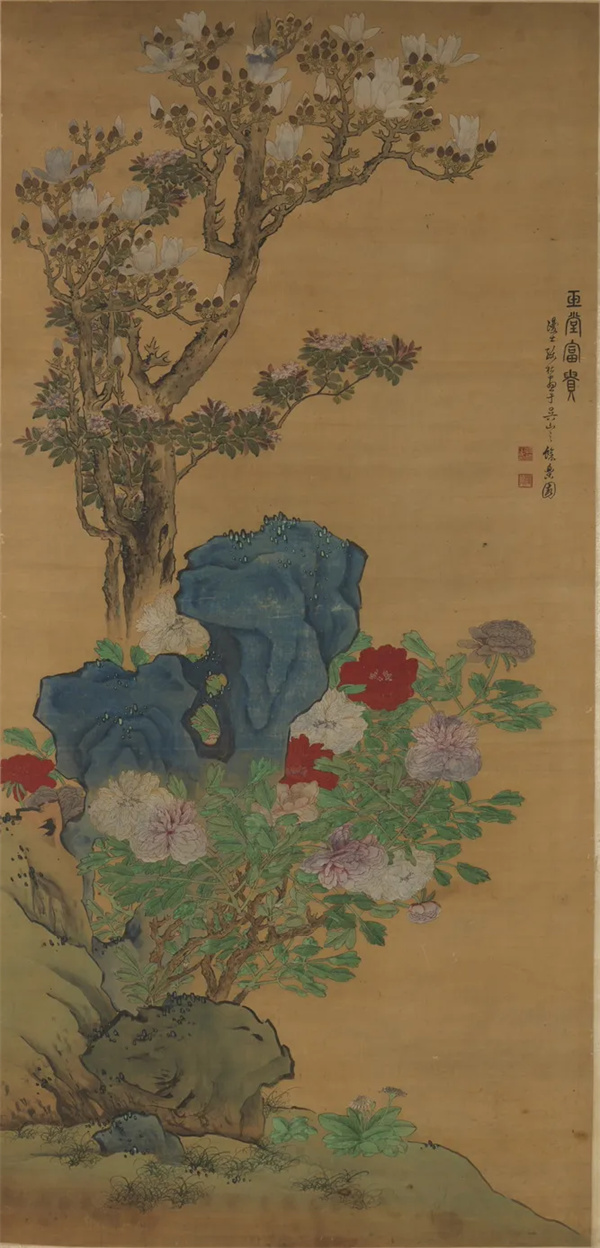
Qing Dynasty Sun Qi's picture of Yutang's wealth and honor. The scroll is inscribed: Yutang's wealth and honor were painted by Manshi Sun Qi in Wushan Zhiyuan.
Sun Jin (date of birth and death unknown), also known as Zizhou, also known as Manshi, also known as Zhuchi, was born in Qiantang (now Hangzhou). He was active in the late Ming and early Qing dynasties, at the same time as Chen Hongshou.
In this painting, magnolias and crabapples, which symbolize wealth and wealth, are painted between the rocks. The composition is elegant, the brushwork is meticulous, the colors are rich and gorgeous, and the painting is magnificent. The double hook outline filling method and the baking and dyeing method are used to depict the different postures of flowers and leaves, which are vivid and expressive, reflecting the artist's excellent sketching skills.

Qing Dynasty Fan Qi's "Three Friends of Suihan" scroll, inscribed: Painted by Fan Qi in the month of Jiaping, Guihai.
Fan Qi (still alive from 1616 to 1694), courtesy name Huigong, was born in Jiangning (now Nanjing, Jiangsu Province) and was one of the "Eight Families of Jinling". Good at painting landscapes, flowers and figures. The landscape painting is done with fine brushwork and is good at drying and dyeing with ink; the flowers are drawn with steady and realistic brushwork and the colors are light.
Fan Qi's flower paintings are famous for their meticulous outlines, but this work is unique because of its freehand brushwork and freehand brushwork. The painting methods of flowers and stones are either scratchy or boneless, and the two are naturally combined, which shows the author's profound painting skills. In the picture, the image of beautiful rocks dyed with ink is the most prominent. The author left gaps between the thick ink blocks to indicate the front-to-back relationship between the stones, which shows his ingenuity.
The plum blossoms, camellias, and daffodils painted in the painting are the flowers corresponding to the Xiaohan solar term in the traditional Chinese phenology "Twenty-Four Flower Trade Winds", so Gong Xian included the poem "Don't have friends in the cold year" in the inscription.

Qing Dynasty Lengmei's figure of squatting dog in Huayin. The scroll is signed: imitation of Xu Xi's figure of squatting dog in Huayin, Dongming Lengmei.
Leng Mei (date of birth and death unknown) was active during the Yongzheng and Qianlong reigns of the Qing Dynasty (1678-1799). The courtesy name is Jichen, the title is Kinmen Waishi, and the other is Kinmen Shushi. A native of Jiaozhou (now Jiao County, Shandong Province). Disciple of Jiao Bingzhen. He is good at painting figures, especially ladies, and he is also good at painting the world. He is a master in the art of painting, and his work is meticulous and beautiful. He was a famous court painter during the Kangxi period.
This picture shows a precious puppy sitting curled up in the shade of flowers. This puppy is almost identical to the puppy painted in the scroll of "Chun Gui Lian Du Tu", except for the slight difference in the color of the hair, which should be based on the original painting. However, the puppy appears as the core shape in this work. The hair is painted in more detail, and the eyes are highlighted, making it more realistic. The artist said that he imitated Xu Xi's brushwork, and the moss spots on the rocks were painted using the "falling ink method" created by Xu Xi.
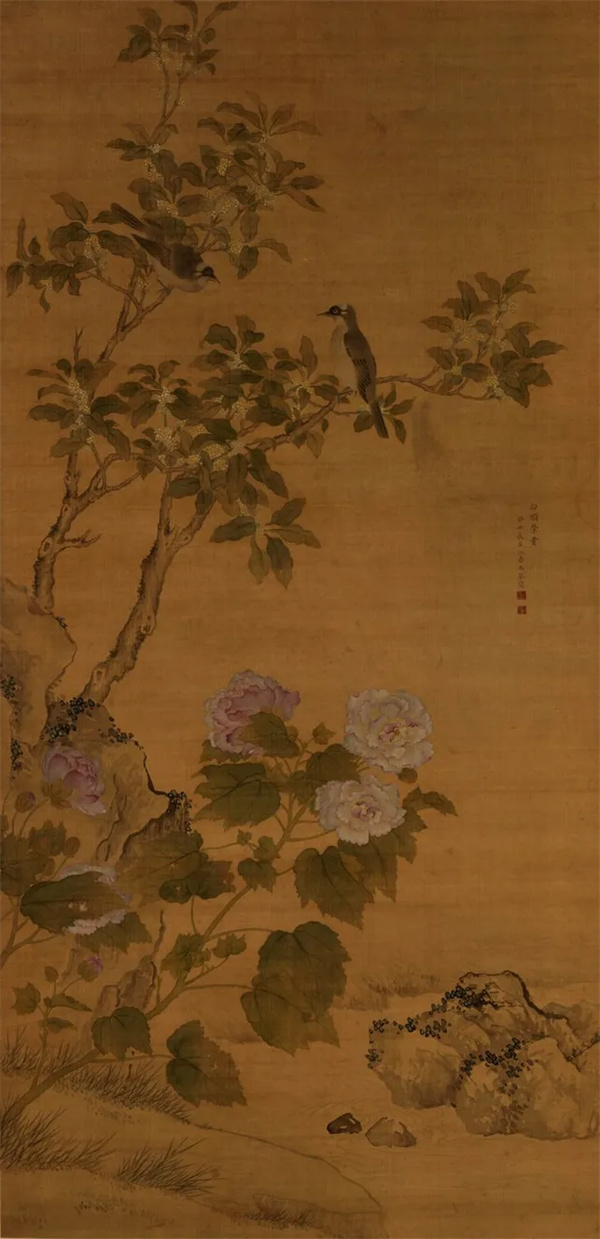
Ma Tsuen, Qing Dynasty, painting of Bai Tou Rong Gui. The scroll is signed: Bai Tou Rong Gui. Guichou grew up to Jiangxiang and was written by Ma Tsuen.
The picture depicts a pair of white-headed crows perched on the sweet-scented osmanthus tree, looking forward to life, which is lifelike. A cluster of hibiscus flowers bloomed one after another, delicate and charming. Pulsatilla, hibiscus and sweet-scented osmanthus symbolize longevity, prosperity and wealth. This method of using the homophonic meaning of the painted subject matter and hoping for wealth and good luck is more common in the topic selection and conception methods of traditional Chinese paintings.
This painting method is combined with writing, using freehand brushwork to paint slope rocks and tree trunks, and use stone green to dot moss. The sweet-scented osmanthus is painted with double hooks, the hibiscus flower is "boneless", the leaves are inscribed with workmanship, and the leaf tendons are outlined with light ink mixed with green flowers. The colors are bright and the picture is exquisite.

Qing Dynasty Zheng Xie's scroll of the picture of wonderful fragrance on the top of the mountain: On the top of a thousand mountains, the deep cracks in the rocks are filled with wonderful fragrance. There are floating clouds under our feet, and we don’t know each other when we come and we don’t stay when we go. It was written by Zheng Xie, a Taoist from Banqiao, in the Hezhou year of Wuyin, Qianlong.
Zheng Xie (1693-1765), courtesy name Kerou and Banqiao, was born in Xinghua, Jiangsu. During the Qianlong period, he served as magistrate of Weixian County, Shandong Province. He was dismissed from office because of false accusations. Later, he went to Yangzhou to make a living by selling calligraphy and painting. He publicly posted a "pen list" to indicate that calligraphy and painting were profitable, and people rushed to buy them. Zheng Xie is famous for his paintings of bamboo, orchid, and stone, and most of his handed down works are of this type. His brushwork is directly inspired by Shi Tao, and he also gets his brushstrokes from Xu Wei, Gao Qipei and others. The tailoring and composition advocate conciseness, and the writing style is free and easy, vigorous and heroic. Black bamboo has many changes and has its own style. The shape is simple and thin. The trunk and branches are thin and thin, but thin but not weak. The leaves are short and fat to enhance the green and lush feeling of the bamboo. The calligraphy name is "six and a half", which is scattered vertically, horizontally and obliquely, like a "street paved with stones", which makes it unique.
This picture is an ink painting of dangerous rocks and orchids and bamboos growing in the crevices of the rocks. The orchids and bamboos are painted with heavy ink, while the rocks are painted with light ink, forming a strong contrast. The orchid grass and bamboo leaves are sharp and crisp, showing their vigorous vitality.
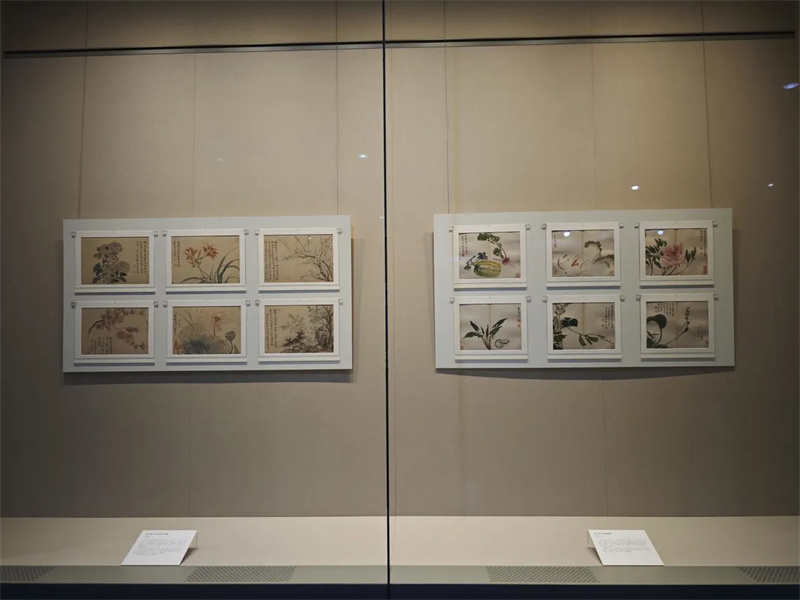
exhibition site
Thanks to the new exhibition cabinets updated by the Tianjin Museum last year, which are made of ultra-high transmittance and low-reflection laminated glass, the exhibition space is more optimized. With the "visible light" lighting design, the audience can be brought as close as possible within the safety range. The distance from the cultural relics restores the details and colors of the cultural relics, enhancing the visual experience and immersive viewing experience. The display form is more novel. In order to maximize the use of the exhibition line and display all the exhibits on display in the United States to domestic audiences, the Tianjin Museum has adopted the display format of album-shaped collections on the wall for the first time, providing a better viewing experience for the audience.
On the morning of May 18th Museum Day, Tianjin Museum will launch a special "Cultural Museum Lecture Hall" to the public. At that time, Zhu Wanzhang, a famous art historian, and Li Kai, a member of the National Appraisal Committee, were invited to conduct in-depth academic exchanges on the theme of "Ming and Qing Flower and Bird Painting Art" in the form of dialogue interviews.


